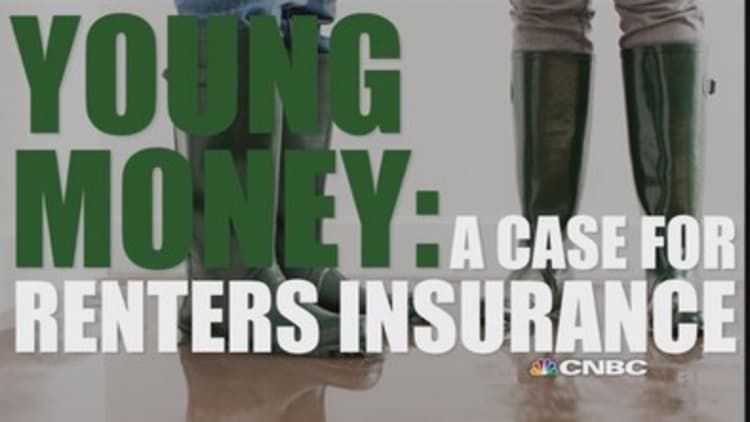
Millennials are more likely to rent than to own their homes. But nearly six in 10 don't have renter's insurance, according to a new survey.
The Insurancequotes.com survey, conducted by Princeton Survey Research Associates, found 60 percent of 18- to 29-year-olds are renters—compared with just 36 percent of all Americans. But the majority of them lack coverage.
"I think that millennials just don't take the time to get renter's insurance," said Dick Power, a certified financial planner and founder of the Walpole, Mass.-based investment advisory firm Power Plans. "They don't have a concept of risk."
Read MoreBought a look at your credit score? You overpaid
Since millennials may not be used to owning much of value, he added, they may not think about insuring their possessions until it's too late. But that can be a costly mistake.
Sean Keating, founder of Patriot Financial Advisors in Eatontown, New Jersey, said that one of his clients was living on the Jersey Shore when Hurricane Sandy struck in the fall of 2012. A carpenter who kept his tools and other work equipment in his home, he didn't have renter's insurance and lost thousands of dollars' worth of equipment to the storm, as well as money from the jobs he had to give up until he could replace them.
Events that devastating are unusual. But even with smaller incidents, from vandalism to water damage from burst pipes, having renters insurance can help you avoid big losses.
How much coverage do you need?
A plan that costs around $300 a year generally covers up to $50,000 worth of property. But most people won't need that much coverage.
Power said an insurance plan that covers $15,000 to $20,000 worth of property should be enough for most millennials. Those plans can work out to less than $200 a year, or as little as $10 to $15 a month. (The average renter's insurance premium cost about $187 in 2012, according to the Insurance Information Institute.)
Read MoreMillennial money habits worth breaking
It's important to check the fine print, though, to see exactly what's covered—and what's not—and how much the deductible is. (That's how much you have to pay toward the damage before the insurance money will kick in.) Standard renter's insurance will typically cover clothes, computers and furniture, but it won't cover expensive valuables like your engagement ring or high-end collectibles like rare baseball cards or artwork. You'll need additional coverage for those.
But the possessions that are covered by a standard policy are typically covered both inside your home and out. So if your laptop is stolen or dropped while you're on vacation, say, you would still be covered. (Make sure to check the policy, though.) Typically, your policy also includes liability insurance, which can help protect you if you are sued by someone who's injured in your home, as well as coverage for temporary living expenses if your home is damaged so badly that it's unlivable. Be aware, though, that some natural disasters, such as earthquakes, floods and, yes, hurricanes, may require riders or add-on coverage.
Actual value or replacement cost?
When you get personal property insurance, you might have the option to select actual cash-value coverage or replacement-cost coverage. Replacement cost coverage means you'll get enough to replace your item with one of the same kind. Say you paid $1,000 for a laptop three years ago, but it's worth a lot less now. Replacement coverage would give you enough for a new laptop. With actual-value coverage, you'd only be paid what the laptop is worth today, which may not be much.
Not surprisingly, replacement coverage typically comes with higher premiums. But it may be worth it, if you've got furniture, electronics or other big-ticket items that are a few years old already. Be aware that there is a limit to the amount of coverage you can get for different items. Each policy lists the specific monetary limits for personal property.
But even with the limits, the coverage can add up to thousands, so the math should work in your favor if your home, or your stuff, is damaged.
Keating sympathizes with those millennials who lack insurance. He was once among them. But he has a warning for them, as well. His apartment got damaged when he was 24, and he had to pay for the repairs and the replacement of his things. "It all came out of my pocket because I didn't pay a hundred bucks for coverage," he remembers. "I had to learn the hard way."


